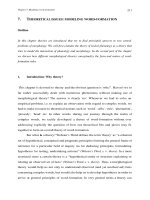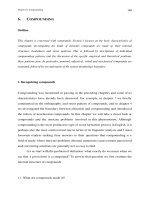Bubble formation at multiple orifices
Bạn đang xem bản rút gọn của tài liệu. Xem và tải ngay bản đầy đủ của tài liệu tại đây (1.7 MB, 109 trang )
BUBBLE FORMATION AT MULTIPLE ORIFICES
XIE SHUYI
(B. ENG, TJU)
A THESIS SUBMITTED
FOR THE DEGREE OF MASTER OF ENGINEERING
DEPARTMENT OF CHEMICAL AND ENVIRONMENTAL ENGINEERING
NATIONAL UNIVERSITY OF SINGAPORE
2003
ACKNOWLEDGEMENTS
I am greatly indebted to my supervisor, Assoc. Prof. Reginald B. H Tan, for his
invaluable guidance and constructive advice throughout this project. I am very fortunate
to have been his student during the years of this study. Without him, this work could not
have been possible.
Many people in the Department of Chemical and Environmental Engineering at National
University of Singapore also gave invaluable support to this project. Particular thanks go
to Dr. Wang Chi-Hwa for providing part of experimental facilities; Mr. Og Kim Poi and
other workshop staff for their help in constructing the experimental apparatus; colleagues
in the laboratory, particularly Dr. Zhang Wenxing, Dr. Deng Rensheng, Dr. Zhu Kewu
and Mr. Zhang Minping for their supportive comments and cheerful assistance.
Special thanks are also due my beloved family members, who always support me and
help me in so many ways. This thesis is dedicated to them.
Finally, I would also like to thank National University of Singapore, for awarding me
with scholarship and every possible practical help to facilitate my work.
i
TABLE OF CONTENTS
Acknowledgements
i
Table of contents
ii
Summary
vii
Nomenclature
ix
List of Figures
xii
List of Tables
xiv
Chapter 1 Introduction
1
1.1 Background
1
1.2 Objective of this work
2
1.3 Organization
3
Chapter 2 Literature Review
2.1 Bubble formation at single orifice
5
5
2.1.1 Bubbling dynamics
6
2.1.1.1 Static regime
6
2.1.1.2 Dynamic regime
7
2.1.1.3 Jetting regime
9
2.1.2 Physical factors affecting bubble formation
10
ii
2.1.2.1 Chamber volume
10
2.1.2.2 Orifice diameter
11
2.1.2.3 Liquid depth
13
2.1.2.4 Liquid properties
14
2.1.2.5 Gas properties
15
2.1.2.6 Liquid cross-flow
16
2.1.2.7 Static system pressure
17
2.1.3 Mathematical modeling
19
2.1.3.1 Spherical models
20
2.1.3.2 Non-spherical models
21
2.2 Bubble formation at multiple orifices
23
2.2.1 Experimental studies
23
2.2.2 Theoretical development
26
2.3 Summary
Chapter 3 Model Description
27
29
3.1 Assumptions
29
3.2 Bubble frequency f
31
3.3 Gas velocity through each orifice Vg
32
3.4 Gas chamber pressure Pc
33
Chapter 4 Experimental Work
35
4.1 Experimental apparatus
35
iii
4.1.1 Bubble column
36
4.1.2 Gas chamber
37
4.1.3 Orifice insert
38
4.1.4 Orifice plate
39
4.1.5 Gas supply system
39
4.2 Measurement techniques
40
4.2.1 Dynamic pressure transducer
40
4.2.2 High-speed video camera
41
4.3 Experimental conditions and procedures
Chapter 5 Results and Discussion
5.1 Bubbling modes at two orifices
5.1.1 Visualization
44
48
48
49
5.1.1.1 Synchronous bubbling
50
5.1.1.2 Alternate bubbling
50
5.1.1.3 Unsteady bubbling
51
5.1.2 Chamber pressure fluctuation
51
5.1.2.1 Synchronous bubbling
55
5.1.2.2 Alternate bubbling
55
5.1.2.3 Unsteady bubbling
56
5.1.3 Fast Fourier result
57
5.1.3.1 Synchronous bubbling
57
5.1.3.2 Alternate bubbling
58
iv
5.1.3.3 Unsteady bubbling
5.2 Effect of bubbling conditions on bubbling synchronicity and frequency
58
60
5.2.1 Orifice spacing
60
5.2.2 Liquid depth
65
5.3 Reproducibility of experimental data
67
5.4 Measurement of synchronicity
68
5.5 Comparison between model predictions and experimental results
70
5.5.1 Bubble frequency
70
5.5.1.1 Gas chamber volume
72
5.5.1.2 Orifice number
75
5.5.1.3 Comparison of experimental and calculated frequencies
75
5.5.2 Bubble radius
75
5.5.2.1 Gas chamber volume
77
5.5.2.2 Orifice number
78
5.5.3 Calculated gas chamber pressure fluctuations
Chapter 6 Conclusions and Recommendations
6.1 Conclusions
79
81
81
6.1.1 Conclusions from experimental investigations on
two-orifice bubbling behavior
6.1.2 Conclusions from mathematical modeling
6.2 Recommendations for future study
81
82
84
v
References
85
Appendix Sample Calculation
93
vi
SUMMARY
This work presents a systematic study of bubbling synchronicity and frequency for
bubble formation at multiple (two to six) orifices. In addition, a simple mathematical
model is proposed to predict bubble frequency and bubble size in synchronous multiorifice bubbling. Experimental results under various conditions are compared with the
model predictions.
High speed video images were applied to visualize bubble formation at the multiple
orifices. A highly sensitive dynamic pressure transducer was employed to record the
instantaneous pressure fluctuations in the gas chamber and time-pressure signals were
used to obtain bubble frequency via Fourier transform.
Regimes of synchronous, alternative and unsteady bubbling were clearly identified, and
the effects of orifice spacing and liquid depth on bubbling synchronicity and frequency
were studied. It is found that the degree of synchronicity generally decreases at high gas
flowrates due to the onset of unsteady bubbling. Both the orifice spacing and liquid depth
can affect the bubbling synchronicity via liquid pressure effects due to bubble-to-bubble
interaction, coalescence and the wake pressure of preceding bubbles.
vii
The modified theoretical model for predicting synchronous bubble frequency in multiorifice bubble formation works well. The predicted values of frequency under a variety of
operating conditions agreed within ±15% with experimental data in the highly
synchronous bubbling regime. These results should provide a sound basis for further
fundamental studies into bubble formation phenomena at multiple orifices.
viii
NOMENCLATURE
Symbol
Description
Unit
a
bubble radius
m
A
orifice area
m2
b
thickness of plate
m
Bo
Bond number, ( Bo = ρ l d 0 g / σ )
c
sound velocity in the gas
do
orifice diameter
CG
orifice coefficient for gas flow
D
diameter of gas chamber
m
f
bubble frequency
s-1
f'
fanning friction factor
Fr
Froude number, ( Fr = V g / d 0 g )
2
dimensionless
g
acceleration due to gravity
m.s-2
H
liquid height
Nc
capacitance number, N c =
Nc
2
'
dimensionless
m.s-1
m
dimensionless
dimensionless
m
capacitance number, N c =
'
g ( ρ l − ρ g )Vc
Aρ g c 2
ρ l gVc
A Ps
dimensionless
dimensionless
ix
N Re
Reynolds number, N Re = 4 ρ g Q / πd 0 µ g
dimensionless
Nw
gas flow rate number
dimensionless
N or
number of orifices
dimensionless
Pb
bubble pressure
Pa
Pc
chamber pressure
Pa
PcDET
chamber pressure at bubble detachment
Pa
Por
liquid pressure at orifice
Pa
Ps
static pressure at orifice
Pa
Pwo
wake pressure at orifice
Pa
Q
average gas injection rate to the chamber
m3.s-1
q
average gas flow rate through each orifice
m3.s-1
s
spacing
m
s or
the perpendicular distance between bubble center and orifice
m
ro
orifice radius
m
t
time
s
tf
bubble formation time
s
tw
waiting time
s
T
time during waiting
s
U
bubble vertical rising velocity
m.s-1
Ul
uniform liquid cross-flow velocity across orifices
m.s-1
VB
bubble volume
m3
x
Vc
chamber volume
Vg
average gas velocity through each orifice
m3
m.s-1
Greek symbols
Symbol
Description
Unit
γ
adiabatic exponent
µg
gas viscosity
σ
surface tension
ρg
gas density
kg.m-3
ρl
liquid density
kg.m-3
dimensionless
kg.m-1.s-1
N.m-1
xi
LIST OF FIGURES
Fig. 2.1
Bubbling state diagram of McCann and Prince (1971) from a 9.4
mm orifice in an air-water system
9
Fig. 2.2
The results of Park et al. (1977)
12
Fig. 2.3
Bubble volume vs. gas flowrate for five system pressures
(adapted from La Nauze and Harris, 1974)
18
Transition of bubbling regimes under different pressure systems
for orifice diameter 3.2 mm and 4.8 mm (adapted from La Nauze
and Harris, 1974)
19
Bubble volume vs. gas flowrate (left) and bubble volumes vs. the
radio between gas chamber volum and orifice number (adapted
from Titomanlio, Rizzo and Acierno (1974)
25
Fig. 3.1
Schematic diagram of physical system
30
Fig. 3.2
Typical gas chamber pressure vs. time for a bubble formation
period
32
Fig. 4.1
Experimental set-up
36
Fig. 4.2
Orifice insert configuration
38
Fig. 4.3
Pressure transducer system
41
Fig. 4.4
High-speed video camera system
42
Fig. 4.5
Typical high-speed frame for bubble formation at a two-orifice
plate
43
High-speed photographic images of bubble formation Vc = 480
cm3, d0 = 1.6 mm, H = 30 cm , s = 1 cm and (a) Q = 2.5 cm3/s; (b)
Q = 4.2 cm3/s; (c) Q = 8.3 cm3/s
52
Chamber pressure fluctuations: Vc = 480 cm3, d0 = 1.6 mm, H = 30
cm, s = 1 cm and (a) Q = 2.5 cm3/s; (b) Q = 4.2 cm3/s; (c) Q = 8.3
cm3/s. Total time = 20 s
56
Fig. 2.4
Fig. 2.5
Fig. 5.1
Fig. 5.2
xii
FFT analysis of chamber pressure fluctuations: Vc = 480 cm3, d0 =
1.6 mm, H = 30 cm, s = 1 cm and (a) Q = 2.5 cm3/s; (b) Q = 4.2
cm3/s; (c) Q = 8.3 cm3/s
58
Percentage of synchronous bubbling versus gas flowrate: Vc = 480
cm3, d0 = 1.6 mm, H = 30 cm. (a) s = 1 cm; (b) s = 4 cm
62
Bubbling frequency and synchronicity for different orifice spacing:
Vc = 480 cm3, d0 = 1.6 mm, H = 30 cm
64
Bubbling frequency and synchronicity for different liquid depths:
Vc = 560 cm3, d0 = 1.6 mm, s = 4 cm
66
Fig. 5.7
Reproducibility of bubble frequency
67
Fig. 5.8
Comparison of average gas velocity vs. frequency between model
predictions and experimental data with chamber volume as a
parameter. Nor = 3, d0 = 1.6 mm, H = 30 cm, s = 4 cm, b = 1 mm,
system: air-water
73
Comparison of frequency between model predictions and
experimental data with orifice number as a parameter. Vc = 480
cm3, d0 = 1.6 mm, H = 30 cm, s = 4 cm, b = 1 mm, system: airwater
74
Measure vs. calculated values of frequency. d0 = 1.6 mm, H = 30
cm, s = 4 cm, b = 1 mm, system: air-water
76
Comparisons of average bubble radius between model predictions
and experimental data with chamber volume as a parameter. Nor =
3, d0 = 1.6 mm, H = 30 cm, s = 4 cm, b = 1 mm, system: air-water
77
Comparison of average bubble radius between model predictions
and experimental data with orifice number as a parameter. Vc =
480 cm3, d0 = 1.6 mm, H = 30 cm, s = 4 cm, b = 1 mm, system: airwater
78
Calculated gas chamber pressure during a bubbling for chamber
volume 480 cm3 and 970 cm3
80
Fig. 5.3
Fig. 5.4
Fig. 5.5
Fig. 5.6
Fig. 5.9
Fig. 5.10
Fig. 5.11
Fig. 5.12
Fig. 5.13
xiii
LIST OF TABLES
Table 2.1
Bubbling state diagram of McCann and Prince (1971) for a 9.4 mm
orifice in an air-water system
8
Table 4.1
Physical properties of air and water at standard conditions
44
Table 4.2
Experimental conditions
45
Table 5.1
Percentage of synchronous signals with volume (Vc) as a
parameter. Nor = 3, d0 = 1.6 mm, H = 30 cm, s = 4 cm, b= 1 mm,
system:air-water
69
Percentage of synchronous signals with chamber volume ( Vc ) as a
parameter. Vc = 480 cm3, d0 = 1.6 mm, H = 30 cm, s = 4cm, b = 1
mm, system: air-water
71
Table 5.2
xiv
Introduction
CHAPTER 1
INTRODUCTION
1.1 Background
The dispersion of gas bubbles in liquids plays an important role in bringing about
efficient mass and heat transfer between the two phases. Important devices include
bubble columns and sieve plate columns, in which bubbles are generated by introducing a
stream of gas through orifices into the liquid phase. Investigations on bubble formation
mainly concern bubble frequency, size, shape, the influence of wake pressure of
preceding bubbles and liquid weeping accompanying bubble formation and detachment.
As a fundamental phenomenon, bubble formation at a single orifice has been widely
studied, although it is not in wide use practically. Numerous theoretical models have been
developed in order to predict bubble size, shape, frequency and rising velocity in single
orifice bubbling. On the other hand, some experimental studies of bubble formation from
industrial perforated plates have been undertaken.
However, few studies have addressed the case of multiple orifices as an extension of
single orifice bubble formation. There is a relative lack of fundamental understanding to
link a comprehensive body of knowledge on single orifices to industrial multi-orifice
distributors. For example, it is fairly obvious that even for two-orifice bubbling, bubble
sizes formed when both orifices are bubbling simultaneously would be different from the
1
Introduction
case when the orifices are “out of phase”. The degree of complexity would rise rapidly
for three and more orifices. Therefore, the prediction of bubbling frequency and bubble
sizes for multi-orifice bubbling becomes a more difficult task when compared with single
orifice bubbling.
1.2 Objective of this work
The motivation for this work is to systematically study bubbling synchronicity and
frequency for bubble formation at multiple orifices. Two main objectives are:
1. Experimentally study bubbling synchronicity and frequency for bubble formation
at two orifices. In particular, clarify the different modes with respect to
synchronous, alternate and unsteady bubbling regimes with operating parameters
of gas flowrate, orifice spacing and liquid height.
2. Propose a simple mathematical model to predict bubbling frequency in
synchronous multi-orifice bubbling. Compare the theoretical predictions of
bubble frequency and average radius with experimental data for various gas
chamber volume and number of orifices respectively.
It is hoped that the study would increase our understanding of the factors affecting
synchronicity and frequency in multi-orifice bubbling. The theoretical model is also
2
Introduction
expected to be able to predict bubbling frequency, bubble radius, and gas chamber
volume under various conditions.
1.3 Organization
This thesis is organized to address the study of bubble formation at multiple orifices both
experimentally and theoretically.
Chapter 2 reviews experimental and theoretical research into bubble formation at single
orifices, which represents the fundamental phenomenon in bubble formation. Important
physical factors affecting bubble formation will be also reviewed in this chapter. In
addition, previous work on multiple-orifice bubbling will be discussed.
Chapter 3 presents a mathematical model, which is a simple extension of a recently
developed single-orifice model. This new model should be able to predict bubble
frequency, bubble volume and gas chamber pressure under specified conditions for
multiple orifices.
Chapter 4 describes the experimental apparatus used in this work.
Measurement
techniques, experimental conditions and procedures will also be summarized in this
chapter.
3
Introduction
Results and discussion are presented in Chapter 5. Various bubbling modes at two-orifice
will be described. Factors influencing the bubbling synchronicity and frequency will be
addressed. In addition, the comparison between theoretical predictions and experimental
results will be also addressed.
Conclusions from the experimental study on bubbling synchronicity and theoretical
predictions of bubble frequency, bubble radius and gas chamber pressure are summarized
in chapter 6. Recommendations arising from this work include suggestions for further
study.
4
Literature Review
CHAPTER 2
LITERATURE REVIEW
The performance of any gas-liquid contacting system mainly depends on a
combination of the system geometrical configuration, operating procedures and
properties of the gas and liquid phases. It is very important that the effect of each
parameter is well understood so that such devices as sieve tray columns could be
reliably and efficiently designed and controlled. For the past several decades,
important research on bubble formation at a single orifice and on perforated plate
bubbling has been conducted, and results of primary practical importance have been
achieved with respect to the influence of each parameter. Studies on bubble formation
at multiple orifices (meaning two to, say, ten) have been relatively scarce, despite the
obvious need to relate the results from single-orifice investigations to industrial multiorifice trays.
The review is composed of there sections. Section 2.1 presents a general description
and discussion of bubble formation at single submerged orifice, which includes an
introduction of bubbling regimes, influence of various parameters on gas-liquid
interaction and theoretical development. Section 2.2 reviews the literature pertinent to
bubble formation at multiple orifices, both experimentally and theoretically. Finally, a
brief summary of this review is presented in section 2.3.
2.1 Bubble formation at single orifice
5
Literature Review
2.1.1 Bubbling dynamics
Volumetric gas flowrate into the gas chamber is a conveniently accessible control
parameter in industrial gas-liquid contacting systems. It is evident that low gas
flowrates lead to ineffective mass and heat transfer (Türkoğlu and Farouk, 1990),
while a highly elevated gas flow rate, resulting in an increased gas momentum, can
cause bubble formation to take on a very irregular behavior and affect mass and heat
transfer consequently (Rennie and Smith, 1965). Based on the gas flow rate, bubbling
regimes can be divided into static, dynamic and jetting regimes.
2.1.1.1 Static regime
The static bubbling regime occurs under the condition where only bubble buoyancy
and surface tension play significant roles and there is equality between these two
forces throughout the bubble formation. The gas flow rate in this regime is normally
very low (<1 cm3/s) (Van Krevelen and Hoftijzer, 1950) and bubble volume remains a
constant value at the detachment. The bubble volume can be calculated as follows:
VB =
πd 0σ
,
(ρl − ρ g )g
(2.1)
where ρ l and ρ g represent the liquid density and gas density respectively, g the
acceleration due to gravity, σ the surface tension and d0 the orifice diameter.
Conditions for constant bubbling volume normally occur when a dimensionless
Reynolds number N Re ( N Re = 4 ρ g Q / πd 0 µ g ) less than 100, where Q is the
volumetric gas flowrate into the gas chamber and µ g is the gas viscosity.
6
Literature Review
2.1.1.2 Dynamic regime
In the most realistic conditions, the gas flow rate is much higher and both bubble
volume and frequency change with an increase in gas flow ( N Re >100). This regime is
called Dynamic regime. Bubbling mode becomes much complicated and is further
divided into six bubbling patterns (McCann and Prince, 1971).
I.
Single bubbling: Bubbles grow successively and discretely and there is
no significant interaction between any two bubbles. This regime occurs
under the conditions of low gas flow rates and small chamber volumes.
II.
Pairing: The phenomenon occurs at large gas chamber volumes and
higher gas flow rates. The detachment of the bubble can cause an
intermediate formation of an elongated gas tube due to the remaining
pressure difference between chamber pressure and orifice pressure at
the moment of the detachment. The gas tube then quickly elongates
and joins with the bubble, connecting it momentarily with the orifice.
After this tube breaks rapidly at the orifice and move into the
preceding bubble, weeping of the liquid through the orifice may be
observed.
III.
Double bubbling: It occurs only at high gas flow rates or low chamber
volumes. The second bubble is sucked into the preceding one due to a
wake force caused by it and then two bubbles merge together and rise
as one. The phenomenon is similar with pairing except that the second
7
Literature Review
bubble cannot be regarded as a tube since its size is almost same with
the preceding bubble. Weeping may occur between two bubbles.
IV.
Double pairing: Similar with behavior of the double bubbling except
that each is a pair.
Single bubbling with delayed release: The bubbling pattern is very
V.
similar with pairing except that there is no clear separation between the
first bubble and the small gas tube.
VI.
Double bubbling with delayed release: The bubbling behavior is very
similar to single bubbling with delayed release except that there is also
double bubbling as a following sequence behind each single delayed
release behavior.
In particular, MaCann and Prince (1971) compared the phenomena of pairing and
double bubbling, as shown in Table 2.1.
Table 2.1 Comparison of “pairing” and “double bubbling” (adapted from McCann and
Prince (1971)).
Pairing
Double bubbling
Large chamber volumes
Small Chamber volumes
Bubbling with a “tail”
Two distinct bubbles
No weeping between the bubble
and the formation of its “tail”
Weeping may occur between the two
bubbles
8
Literature Review
Figure 2.1 shows the state diagram of McCann and Prince (1971) for a 9.4 mm orifice
in an air-water system. The conditions were summarized under which each of six
categories was observed to occur.
Figure 2.1 Bubbling state diagram of McCann and Prince (1971) for a 9.4 mm orifice
in an air-water system
2.1.1.3 Jetting regime
With increasing gas flow rates, bubbling regime loses its stability. Bubbling is
characterized by the onset of rapid sequential formation of bursts. This regime is
called “jetting regime”. The phenomenon of jetting normally occurs at higher
Reynolds numbers ( N Re >2000) (McNallan and King (1982)).
9
Literature Review
2.1.2 Physical factors affecting bubble formation
Many factors have been investigated to be expected to influence the bubble formation
at a single orifice (Jackson, 1964). The following subsections will review the
knowledge on components of the gas-liquid system and their effect on the bubble
formation.
2.1.2.1 Chamber volume
Gas chamber volume plays an important role in gas-liquid contacting system. Two
regimes are defined depending on the gas chamber volume: constant flow and
constant pressure.
Constant flow conditions occur in small gas chamber volume systems, corresponding
to large hole pressure drop due to either high gas flow rates or large hole resistance.
The changes in the gas chamber or bubble pressure have relatively a small effect on
the pressure drop. The gas flow rate tends toward a constant value.
The occurrence of constant pressure arises for a large chamber volume and fixed
chamber pressure (Kupferberg and Jameson, 1969; Park et al., 1977). Under such a
condition, the pressure fluctuation due to the bubble formation and detachment is
small. Therefore the chamber pressure remains virtually constant.
Hughes et al. (1955) developed a dimensionless capacitance number Nc from an
electrical equivalent to the injection system:
10









